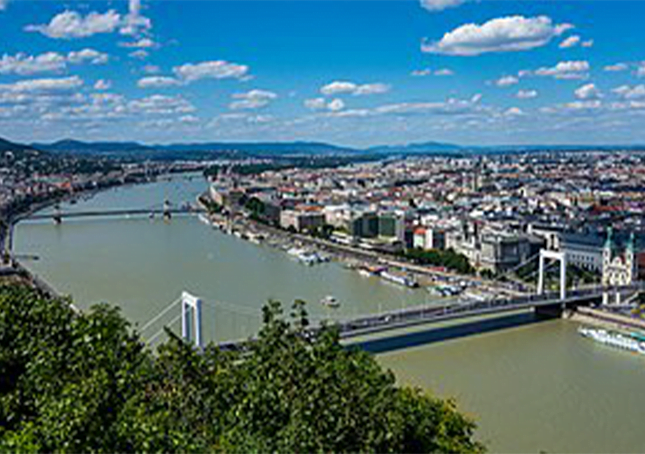Danube

The Danube (/ˈdæn.juːb/ DAN-yoob; known by various names in other languages) is Europe’s second-longest river after the Volga, flowing through much of Central and Southeastern Europe, from the Black Forest into the Black Sea. Its longest headstream Breg rises in Furtwangen im Schwarzwald, while the river carries its name from its source confluence in Donaueschingen onwards.
The Danube was once a long-standing frontier of the Roman Empire and today is the river running through the largest number of countries in the world (10; the Nile is second with 9). Originating in Germany, the Danube flows southeast for 2,850 km (1,770 mi), passing through or bordering Austria, Slovakia, Hungary, Croatia, Serbia, Romania, Bulgaria, Moldova and Ukraine before draining into the Black Sea.
Its drainage basin extends into nine more countries. The largest cities on the river are Vienna, Budapest, Belgrade and Bratislava, all of which are the capitals of their respective countries. Six more capital cities lie in the Danube’s basin: Bucharest, Sofia, Zagreb, Ljubljana, Sarajevo and Pristina. The fourth-largest city in its basin is Munich, the capital of Bavaria, standing on the Isar River.
The Danube river basin is home to fish species such as pike, zander, huchen, Wels catfish, burbot and tench. It is also home to a large diversity of carp and sturgeon, as well as salmon and trout. A few species of euryhaline fish, such as European seabass, mullet, and eel, inhabit the Danube Delta and the lower portion of the river.
Since ancient times, the Danube has been a traditional trade route in Europe. Today, 2,415 km (1,501 mi) of its total length are navigable. The Danube is linked to the North Sea via the Rhine–Main–Danube Canal, connecting the Danube at Kelheim with the Main at Bamberg. The river is also an important source of hydropower and drinking water.
Danube is an Old European river name derived from a Proto-Indo-European *dānu. Other European river names from the same root include the Dunaj, Dzvina/Daugava, Don, Donets, Dnieper, Dniestr, Dysna and Tana/Deatnu. In Rigvedic Sanskrit, dānu means “fluid, dewdrop” and dānuja means “born from dānu” or “born from dew-drops”. In Avestan, the same word means “river”. In the Rigveda, Dānu once appears as the mother of Vrtra, “a dragon blocking the course of the rivers”. The Finnish word for Danube is Tonava, which is most likely derived from the word for the river in German, Donau. Its Sámi name Deatnu means “Great River”. It is possible that dānu in Scythian as in Avestan was a generic word for “river”: Dnieper and Dniestr, from Danapris and Danastius, are presumed to continue Scythian *dānu apara “far river” and *dānu nazdya- “near river”, respectively.
The river was known to the ancient Greeks as the Istros (Ἴστρος)[3] a borrowing from a Daco-Thracian name meaning ‘strong, swift’, from a root possibly also encountered in the ancient name of the Dniester (Danaster in Latin, Tiras in Greek) and akin to Iranic turos ‘swift’ and Sanskrit iṣiras (इषिरस्) ‘swift’, from the PIE *isro-, *sreu ‘to flow’.[4] In the Middle Ages, the Greek Tiras was borrowed into Italian as Tyrlo and into Turkic languages as Tyrla, the latter further borrowed into Romanian as a regionalism (Turlă).
The Thraco-Phrygian name was Matoas, “the bringer of luck”.
In Latin, the Danube was variously known as Danubius, Danuvius, Ister or Hister. The Latin name is masculine, as are all its Slavic names, except Slovenian (the name of the Rhine is also masculine in Latin, most of the Slavic languages, as well as in German). The German Donau (Early Modern German Donaw, Tonaw, Middle High German Tuonowe) is feminine, as it has been re-interpreted as containing the suffix -ouwe “wetland”.
Romanian differs from other surrounding languages in designating the river with a feminine term, Dunărea. This form was not inherited from Latin, although Romanian is a Romance language.[10] To explain the loss of the Latin name, scholars who suppose that Romanian developed near the large river propose[10] that the Romanian name descends from a hypothetical Thracian *Donaris. The Proto-Indoeuropean root of this presumed name is related to the Iranic word “don-“/”dan-“, while the supposed suffix -aris is encountered in the ancient name of the Ialomița River, Naparis, and in the unidentified Miliare river mentioned by Jordanes in his Getica. Gábor Vékony says that this hypothesis is not plausible, because the Greeks borrowed the Istros form from the native Thracians.[10] He proposes that the Romanian name is loanword from a Turkic language (Cuman or Pecheneg).
The Middle Mongolian name for the Danube was transliterated as Tho-na in 1829 by Jean-Pierre Abel-Rémusat.
The modern languages spoken in the Danube basin all use names related to Dānuvius: German: Donau (IPA: [ˈdoːnaʊ] (About this soundlisten)); Bavarian: Doana; Silesian: Důnaj; Upper Sorbian: Dunaj; Czech: Dunaj (IPA: [ˈdunaj]); Slovak: Dunaj (IPA: [ˈdunaj]); Polish: Dunaj (IPA: [ˈdunaj] (About this soundlisten)); Hungarian: Duna (IPA: [ˈdunɒ] (About this soundlisten)); Slovene: Donava (IPA: [ˈdóːnaʋa]); Serbo-Croatian: Dunav / Дунав (IPA: [dǔna(ː)ʋ]); Romanian: Dunărea (IPA: [ˈdunəre̯a]); Bulgarian: Дунав, romanized: Dunav (IPA: [ˈdunɐf]); Russian: Дунай, romanized: Dunaj (IPA: [dʊˈnaj]); Ukrainian: Дунай, romanized: Dunaj (IPA: [dʊˈnɑj]); Greek: Δούναβης (IPA: [ˈðunavis]); Italian: Danubio (IPA: [daˈnuːbjo]); Spanish: Danubio; (Spanish pronunciation: [daˈnuβjo]); Turkish: Tuna; Romansh: Danubi; Albanian: Tunë, definite Albanian form: Tuna.[12]
